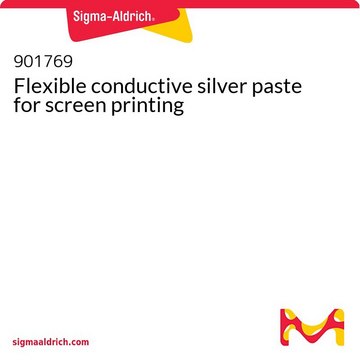923575
Silver nano ink
Screen printable, Photonically curable
Synonim(y):
Ag NP-based ink, Photonically curable Ag ink, S-CS21306, Screen printable Ag ink, Silver (Ag) Nanoparticle Ink, Silver nano ink
About This Item
Polecane produkty
Poziom jakości
opór arkusza
15.6m Ω/sq, 25 mum after curing at 150 Celsius for 5 min on glass
7.5m Ω/sq, 25 mum after curing at 200 Celsius for 5 min on glass
75m Ω/sq, 25 mum after curing at 120 Celsius for 1h on glass
lepkość
6500-10000 mPa.s(20 °C) (@100/s)
temp. przechowywania
2-8°C
Szukasz podobnych produktów? Odwiedź Przewodnik dotyczący porównywania produktów
Zastosowanie
Process: Rotary screen printing (below 80μm of resolution)
This ink has been developed to allow photonical curing to enable high throughput printing.
Compatible Printing Method: screen printing,
Compatible substrates: PET (Melinex 406, Melinex 339, Melines 520, Arcophane TCA, Arcophane STS, Folex BG-71), PEN (Teonex), Kapton® , Ceramic
Recommended surface treatment for substrates:
- Temperature stabilization
- Argon plasma treatment
Cechy i korzyści
- Good bending resistance, smooth surface
- Superior conductivity
- High resolution
- Curing process compatibility: photonic, NIR, low vacuum oven, thermal curing
- High nano-particle content
- Non-toxic (No CMR ink)
Uwaga dotycząca przygotowania
- Inox, 18 µm mesh thickness, 640/inch-250/cm mesh count, 45 degree mesh angle, 7 µm emulsion thickness, 50 µm resolution, 83 m2/kg theoretical coverage, 1 µm theoretical dried thickness.
- Inox, 19 µm mesh thickness, 500/inch-200/cm mesh count, 22.5 degree mesh angle, 5 µm emulsion thickness, 40 µm resolution, 80 m2/kg theoretical coverage, 1 µm theoretical dried thickness.
- Polyester, 30 µm mesh thickness, 380/inch-150/cm mesh count, 22.5 degree mesh angle, 10 µm emulsion thickness, 80 µm resolution, 50 m2/kg theoretical coverage, 1.6 µm theoretical dried thickness.
Informacje prawne
Hasło ostrzegawcze
Warning
Zwroty wskazujące rodzaj zagrożenia
Zwroty wskazujące środki ostrożności
Klasyfikacja zagrożeń
Aquatic Acute 1 - Aquatic Chronic 1 - Eye Irrit. 2 - Skin Irrit. 2
Kod klasy składowania
10 - Combustible liquids
Klasa zagrożenia wodnego (WGK)
WGK 3
Wybierz jedną z najnowszych wersji:
Certyfikaty analizy (CoA)
Przepraszamy, ale COA dla tego produktu nie jest aktualnie dostępny online.
Proszę o kontakt, jeśli potrzebna jest pomoc Obsługa Klienta
Masz już ten produkt?
Dokumenty związane z niedawno zakupionymi produktami zostały zamieszczone w Bibliotece dokumentów.
Nasz zespół naukowców ma doświadczenie we wszystkich obszarach badań, w tym w naukach przyrodniczych, materiałoznawstwie, syntezie chemicznej, chromatografii, analityce i wielu innych dziedzinach.
Skontaktuj się z zespołem ds. pomocy technicznej









